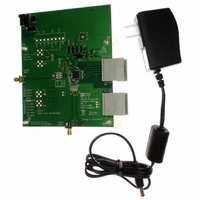AD9211-300EBZ Analog Devices Inc, AD9211-300EBZ Datasheet - Page 21

AD9211-300EBZ
Manufacturer Part Number
AD9211-300EBZ
Description
10-Bit 300 Msps ADC
Manufacturer
Analog Devices Inc
Datasheet
1.AD9211BCPZ-200.pdf
(28 pages)
Specifications of AD9211-300EBZ
Number Of Adc's
1
Number Of Bits
10
Sampling Rate (per Second)
300M
Data Interface
Serial
Inputs Per Adc
1 Differential
Input Range
0.98 ~ 1.5 V
Power (typ) @ Conditions
437mW @ 1.8 V
Voltage Supply Source
Analog and Digital
Operating Temperature
-40°C ~ 85°C
Utilized Ic / Part
AD9211
Lead Free Status / RoHS Status
Lead free / RoHS Compliant
Clock Jitter Considerations
High speed, high resolution ADCs are sensitive to the quality of the
clock input. The degradation in SNR at a given input frequency
(f
In this equation, the rms aperture jitter represents the root mean
square of all jitter sources, including the clock input, analog input
signal, and ADC aperture jitter specifications. IF undersampling
applications are particularly sensitive to jitter (see Figure 47).
The clock input should be treated as an analog signal in cases
where aperture jitter may affect the dynamic range of the AD9211.
Power supplies for clock drivers should be separated from the
ADC output driver supplies to avoid modulating the clock signal
with digital noise. Low jitter, crystal-controlled oscillators make
the best clock sources. If the clock is generated from another
type of source (by gating, dividing, or other methods), it should
be retimed by the original clock at the last step.
Refer to the
application note for more in-depth information about jitter
performance as it relates to ADCs (visit www.analog.com).
POWER DISSIPATION AND POWER-DOWN MODE
The power dissipated by the AD9211 is proportional to its
sample rate. The digital power dissipation does not vary much
because it is determined primarily by the DRVDD supply and
bias current of the LVDS output drivers.
By asserting PWDN (Pin 29) high, the AD9211 is placed in
standby mode or full power-down mode, as determined by the
contents of Serial Port Register 08. Reasserting the PWDN pin
low returns the AD9211 to its normal operational mode.
An additional standby mode is supported by means of varying
the clock input. When the clock rate falls below 20 MHz, the
AD9211 assumes a standby state. In this case, the biasing network
and internal reference remain on, but digital circuitry is powered
down. Upon reactivating the clock, the AD9211 resumes normal
operation after allowing for the pipeline latency.
A
) due only to aperture jitter (t
SNR Degradation = 20 × log
130
120
110
100
90
80
70
60
50
40
30
1
10 BITS
8 BITS
RMS CLOCK JITTER REQUIREMENT
Figure 47. Ideal SNR vs. Input Frequency and Jitter
AN-501
ANALOG INPUT FREQUENCY (MHz)
application note and the
10
0.125ps
0.25ps
J
0.5ps
1.0ps
2.0ps
) can be calculated by
10
[½ × π × f
100
A
× t
AN-756
J
]
16 BITS
14 BITS
12 BITS
1000
Rev. 0 | Page 21 of 28
DIGITAL OUTPUTS
Digital Outputs and Timing
The AD9211 differential outputs conform to the ANSI-644
LVDS standard on default power-up. This can be changed to a
low power, reduced signal option similar to the IEEE 1596.3
standard using the SPI. This LVDS standard can further reduce
the overall power dissipation of the device, which reduces the
power by ~39 mW. See the Memory Map section for more
information. The LVDS driver current is derived on-chip and
sets the output current at each output equal to a nominal
3.5 mA. A 100 Ω differential termination resistor placed at the
LVDS receiver inputs results in a nominal 350 mV swing at the
receiver.
The AD9211 LVDS outputs facilitate interfacing with LVDS
receivers in custom ASICs and FPGAs that have LVDS capability
for superior switching performance in noisy environments.
Single point-to-point net topologies are recommended with a
100 Ω termination resistor placed as close to the receiver as
possible. No far-end receiver termination and poor differential
trace routing may result in timing errors. It is recommended
that the trace length is no longer than 24 inches and that the
differential output traces are kept close together and at equal
lengths.
An example of the LVDS output using the ANSI standard (default)
data eye and a time interval error (TIE) jitter histogram with
trace lengths less than 24 inches on regular FR-4 material is
shown in Figure 48. Figure 49 shows an example of when the
trace lengths exceed 24 inches on regular FR-4 material. Notice
that the TIE jitter histogram reflects the decrease of the data eye
opening as the edge deviates from the ideal position. It is up to
the user to determine if the waveforms meet the timing budget
of the design when the trace lengths exceed 24 inches.
Figure 48. Data Eye for LVDS Outputs in ANSI Mode with Trace Lengths Less
–100
–200
–300
–400
–500
500
400
300
200
100
0
–3
–2
than 24 Inches on Standard FR-4, AD9211-250
–1
TIME (ns)
0
1
2
3
14
12
10
8
6
4
2
0
–40
–20
TIME (ps)
0
AD9211
20
40










